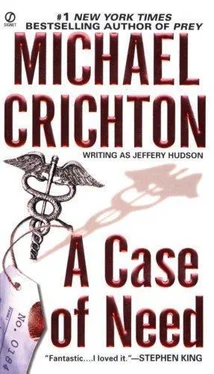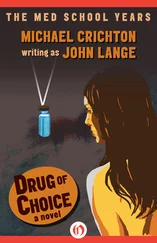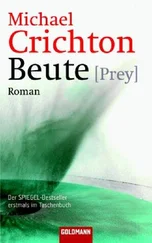Michael Crichton - A Case of Need
Здесь есть возможность читать онлайн «Michael Crichton - A Case of Need» весь текст электронной книги совершенно бесплатно (целиком полную версию без сокращений). В некоторых случаях можно слушать аудио, скачать через торрент в формате fb2 и присутствует краткое содержание. Город: New York, Год выпуска: 2003, ISBN: 2003, Издательство: Signet, Жанр: thriller_medical, на английском языке. Описание произведения, (предисловие) а так же отзывы посетителей доступны на портале библиотеки ЛибКат.
- Название:A Case of Need
- Автор:
- Издательство:Signet
- Жанр:
- Год:2003
- Город:New York
- ISBN:9780451210630
- Рейтинг книги:5 / 5. Голосов: 1
-
Избранное:Добавить в избранное
- Отзывы:
-
Ваша оценка:
- 100
- 1
- 2
- 3
- 4
- 5
A Case of Need: краткое содержание, описание и аннотация
Предлагаем к чтению аннотацию, описание, краткое содержание или предисловие (зависит от того, что написал сам автор книги «A Case of Need»). Если вы не нашли необходимую информацию о книге — напишите в комментариях, мы постараемся отыскать её.
A Case of Need — читать онлайн бесплатно полную книгу (весь текст) целиком
Ниже представлен текст книги, разбитый по страницам. Система сохранения места последней прочитанной страницы, позволяет с удобством читать онлайн бесплатно книгу «A Case of Need», без необходимости каждый раз заново искать на чём Вы остановились. Поставьте закладку, и сможете в любой момент перейти на страницу, на которой закончили чтение.
Интервал:
Закладка:
There is another problem involving medical ethics, and that concerns the doctor and the drug companies. This is currently being fought over in a four-way tug-of-war involving patient, doctor, government, and drug manufacturer. The issues, and the eventual outcome, are still unclear.
About the Author
MICHAEL CRICHTON graduated from Harvard Medical School and served his internship before deciding to devote himself full-time to writing. A CASE OF NEED was first published when he was twenty-six years old. His more recent novels include DISCLOSURE and JURASSIC PARK
Footnotes
1
Geriatrics.
2
The files containing the history of treatment of patients in the hospital. Called a “chart” because the bulk of the file consists of daily charts of temperature, blood pressure, pulse and respiration, the so-called “vital signs.”
3
Diagnosis.
4
Crepitant means it is crackly and filled with air. This is normal.
5
Emergency ward.
6
Chief complaint, the term for the medical disorder that brings the patient to seek treatment.
7
A test of the amount of hemoglobin, or red cells, in the blood.
8
This happens a lot in medicine. For example, a patient presents with fever, leukocytosis—increased numbers of white cells—and pain in the right-lower quadrant of the abdomen. The obvious diagnosis is appendicitis. The surgeon may perform an appendectomy only to find that the appendix is normal. But he is vindicated, so long as he is not overhasty, because the evidence is consistent with appendicitis, and delay may be fatal.
9
Position as an intern or resident, where one is an M.D. but not licensed to practice, and still completing education.
10
Formerly the most violent area in Boston was Scollay Square, but it was demolished five years ago to make way for government buildings. Some consider that an improvement; some a step backward.
11
The frequently bizarre cases mean that every doctor and surgeon has a backlog of strange stories. One surgeon is fond of telling how he was on the Accident Floor—the City’s EW—when two victims of an auto accident were brought in. One man had lost his leg at the knee. The other had massive crush injury to the chest, so bad that the degree of damage could not at first be ascertained from the heavy bleeding. On an X ray of the chest, however, it was seen that one man’s foot and lower leg had been rammed into the second man’s chest, where it was lodged at the time of admission.
12
Dead on arrival at hospital.
13
The seeping of blood to the lowest portions of the body after death. It often helps establish the position of the body.
14
Pelvic Inflammatory Disease, usually infection of the fallopian tubes by Neisseria gonococcus, the agent of gonorrhea. Gonorrhea is considered to be the most common infectious disease of mankind. Twenty percent of prostitutes are thought to be infected.
15
Deaner is a traditional term for the man who takes care of the dissecting room. It is an ancient term, dating back to the days when anatomy dissections were done by horse gelders and butchers. The deaner keeps the rooms clean, cares for the corpses, and aids in the dissection.
16
A drug to contract the uterus, useful for initiating birth and for stopping uterine bleeding.
17
See Appendix I: Delicatessen Pathologists.
18
Boston Lying-in Hospital.
19
Stillbirths, abortuses, and placentas are in hot demand at the BLI for the dozen or so groups doing hormone research.
20
Thirst is an important symptom in shock. For unknown reasons, it appears only in severe shock due to fluid loss, and is regarded as an ominous sign.
21
White count and hematocrit.
22
Five percent dextrose in water, used to replace lost fluid volume.
23
Penicillin reactions occur in 9–10 percent of normal patients.
24
Intramuscularly.
25
Blue.
26
See Appendix II: Cops and Doctors.
27
See Appendix III: Battlefields and Barberpoles.
28
Shock blocks are simply wooden blocks used to elevate the legs in cases of shock, helping to get blood to the head.
29
The English court physician who, in 1628, discovered that blood circulated in a closed loop.
30
A doctor cannot change his name after receiving his M.D. degree without invalidating that degree. This means that there is a great rush in the final weeks of med school among doctors flocking into court to change their names before they receive their diplomas.
31
A paralyzed man will swing a paralyzed arm less than a good arm.
32
Normal white count is 4-9,000 cells/cubic centimeter. With infection, this may double or triple.
33
Breastbone.
34
AP is anteroposterior, indicating that the X rays penetrated from front to back, where they struck the plate. LAO is left anterior oblique and IVP is contrast media in the genitourinary tract, a film showing kidneys, ureters, and bladder.
35
These are ways of making skull films easier to interpret. An arteriogram is an X ray taken after the cerebral arteries have been filled with radio opaque liquid. A PEG, or pneumoencephalogram, consists of draining all the cerebrospinal fluid and pumping in air to increase contrast in the ventricles. It is a painful procedure which cannot be done under anesthesia. Both techniques are considered minor surgery, and are not done unless there is good evidence for their necessity.
36
See Appendix IV: Abbreviations.
37
The fourth class, analgesics, was mostly that old standby, aspirin, synthesized in 1853. Aspirin is as much a wonder drug as any other. It is a painkiller, a swelling-reducer, a fever-breaker, and an antiallergic drug. None of its actions can be explained.
38
See Appendix V: Whites.
39
Injected amphetamines, such as methedrene, intravenously.
40
Psychiatrists have the highest suicide rate of all, more than ten times that of the GP.
41
Defined as a person who becomes more inebriated than his blood alcohol levels would explain. In the most extreme cases, a single drink may make a man a raving, destructive lunatic.
42
The Papp smear is the most accurate diagnostic test in all of medicine.
43
See Appendix VI: Arguments on Abortion.
44
See Appendix VII: Medical Morals.
45
Goodman and Gilman, The Pharmacological Basis of Therapeutics, the definitive text of pharmacology used by doctors. There is a discussion of the effects of marijuana on page 300 which has been widely quoted in recent legal proceedings.
Читать дальшеИнтервал:
Закладка:
Похожие книги на «A Case of Need»
Представляем Вашему вниманию похожие книги на «A Case of Need» списком для выбора. Мы отобрали схожую по названию и смыслу литературу в надежде предоставить читателям больше вариантов отыскать новые, интересные, ещё непрочитанные произведения.
Обсуждение, отзывы о книге «A Case of Need» и просто собственные мнения читателей. Оставьте ваши комментарии, напишите, что Вы думаете о произведении, его смысле или главных героях. Укажите что конкретно понравилось, а что нет, и почему Вы так считаете.









